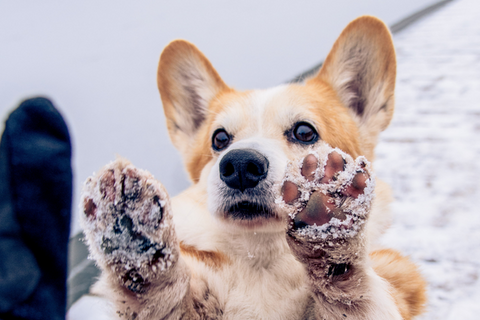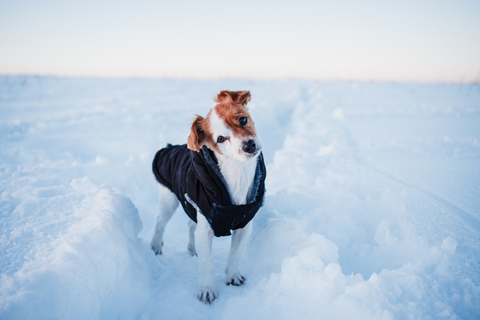
How To Keep Your Dog Safe And Warm On Icy Winter Walks
WRITTEN BY
Holly Kinmont
Share
Cold weather and dogs don’t always mix. Just like people, pets need to be wrapped up on icy winter days, but unlike their owners, dogs aren’t always the best at telling you when they’re too cold.
So how do you know when it’s too cold for taking your dog on a stroll? And how should you keep them warm when it is okay to take them out? We’ll answer all those questions and more here in our guide to keeping your dog safe on winter walks.
Keep An Eye On The Temperature
While you know if it’s too cold for yourself just by heading outside, for your canine companion, it’s necessary to keep an eye on the temperature. In severe winter weather, dogs can become at risk of hypothermia and other health conditions such as frostbite.
The outside air temperature can tell you if it’s safe enough to take your dog on a walk or not. It can also tell you just how much they need to be protected from the cold if you do take them out. Place a thermometer on an external wall, or consult your favourite weather forecasting app to track the temperature.
Different breeds have higher tolerance for cold weather than others, with larger dogs much more hardy in freezing conditions compared to their smaller brethren. The smallest dogs, like Chihuahuas and Terriers, will become the first to feel uncomfortable in cold conditions, and precautions should be taken once the temperature drops below 4°C. If the temperature plummets below -4°C, then it could be dangerous to take them on a walk. Luckily, smaller breeds require less exercise and so a lot of stimulation whilst at home should be enough to keep them active.
Larger dogs, like labradors and German Shepherds, have a slightly higher tolerance for cold conditions. Keep an eye on them though in conditions below 1°C, and avoid taking them out if it’s below -6°C.
The Warning Signs
While your pooch can’t exactly tell you if it’s too cold out, there are a number of behaviour changes which could indicate that they’ve become too uncomfortable on an icy day.
First of all, if they’re usually jumping for joy whenever you grab their lead, but on a cold day they’re retreating into their bed instead, it may be their way of subtly trying to tell you that it’s far too cold for them to be heading out.

But of course it’s not always the weather that has a dog hiding in their bed. If you think it’s warm enough, and you’ve managed to get them outside, there’s still plenty of signs to look out for which could signal they’re feeling uncomfortable.
If they’re whining or cowering on a walk, it’s a sure fire sign it’s time to head back indoors. If the ground is particularly icy, it could be painfully cold on a dog’s exposed paws, and behaviour such as this can indicate they’re not only uncomfortable, but in pain too. In these situations, it’s far better to curtail or skip a walk rather than force them to put up with it.
How To Adapt Walks To The Weather
While skipping the odd walk won’t cause your dog any harm, they could easily end up figuratively (or literally) climbing the walls during a particularly lengthy cold spell.
So if you have to take them out in really cold conditions, keep walks short and snappy. If you usually spend hours charting through the countryside during the weekend, replace it with a short 15-30 minute walk. If it’s below -4°C out, keep walks as quick as possible, and be sure to pay attention to any of those signs of discomfort mentioned earlier.
Walks aren’t the only form of canine exercise of course, so stock up on some fun indoor toys they can play with inside the house to fill any gaps in your regular dog walking routine.
Wrap Them Up With The Right Clothing
While for most dogs, their natural coat of fur is enough protection for most of the year, in the winter they may need some new threads.

No matter how cold it is, your dog will appreciate an extra layer of protection when out in the winter. And if you’re facing a particularly lengthy cold snap, clothing could help you maintain your walking routine even on very cold days.
Choose a coat that wraps your dog’s stomach and chest, as these areas are especially prone to getting cold. Protecting these core areas of their body will help maintain their body temperature even when it’s freezing. Some coats come with advanced insulation usually found in the coats humans wear, ensuring dogs stay protected even in the harshest of conditions.
While (most) dogs have a natural coat of fur to keep their body somewhat warm, no dog has any protection for their paws. Can you imagine how painful it would be to walk through snow without shoes on? Dogs don’t need to imagine. So for the most extreme of cold weather conditions, protect their paws with a pair of dog boots or booties. These will keep their paws covered, while providing a protective layer between them and the icy floor. A dog with very thin legs, like a greyhound, may also benefit from a pair of legwarmers.
Keep The Cold At Bay
Winter is a challenging time for everyone, dogs included. But just like you can invest in a big winter coat to get you through to springtime, there’s plenty of ways to keep your dog protected during cold weather.
As long as you keep an eye on the temperature, pay close attention to their behaviour, and wrap them up with a coat and some doggy booties during harsher conditions, they’ll be skipping their way through the colder months with their tail wagging.
Looking for a hearty meal to keep your dog fired up this winter? Our nutritious and natural raw frozen and cold pressed meals are the perfect way to keep them energised on cold days.




